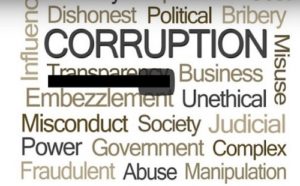Being “good” can get you far in our world. Good behavior wins praise, commuted jail terms, and tangible rewards. Good deeds net accolades and often tax benefits. Good things come to those who wait, who do good for others, who spread good “karma.” And we celebrate “goodness” the most during this time of year.
But what if our “good” deeds are just a mask for the bad things we hide insideSource
When a bank is making a lot of money while seemingly taking little risk in a small branch far from head office, there are two possibilities. The first is that it has invented a legitimate service that competitors will soon start to copy. The second is that it is about to get into terrible trouble. The second has transpired for Danske Bank and Swedbank in Estonia — the magic formula turned out to be alleged money laundering for Russian criminals and oligarchs, who were using the banks to move suspicious cash abroad. Swedbank last week dismissed its chief executive Birgitte Bonnesen, following the ousting of Thomas Borgen, Danske chief executive, in September.
The Russian laundromat scandal that has enveloped Nordic banks, and is drawing in others in Austria and elsewhere, raised big red flags. As with cases of rogue trading such at Barings in Singapore in the 1990s, and mysteriously profitable “innovations” such as at AIG’s London credit derivatives unit before the 2008 crash, big profits were pouring out of a tiny business. Much of banking is highly competitive and no one is incentivised to look a gift horse in the mouth; Ms Bonnesen and Mr Borgen had both previously run their banks’ Baltics businesses. But when a unit makes a 400 per cent return on capital (as did Danske’s Estonian operation for non-residents in 2013) in an industry that struggles to reach double figures, caution is required.
There must be a reason why a small group of customers is willing to pay any bank so much. Some 15,000 Danske customers, mostly non-residents from Russia and former Soviet states, ran €200bn through its Estonian bank, contributing 99 per cent of the branch’s 2013 profits before bad debts. Obtaining entry to the EU banking system via Estonia was priceless. As usual with such disasters, Danske believed that it was not only making lucrative profits but running minimal risk. “The branch took no credit risks of any significance,” records Danske’s internal report into its failure by a Danish law firm.
This made its return on capital huge compared with traditional banking — lending to borrowers who may not repay their debts. Banking’s story for three decades, reaching back to the Scandinavian banking crisis of the early 1990s, has been a quest to find alternative sources of revenue to credit. The problem with lending is that it seems profitable for a long time, but the real return is lowered by periodic crises and asset write-offs, often related to property loans. That led many banks into investment banking and trading in the 2000s, when many credit derivatives turned out to be a means of packaging lending risk rather than abolishing it. It also led into private banking, which is a luxury business if your customers are not tax avoiders or criminals, and to the mundane but reliable activity of transaction banking and trade finance.
The Estonian branches of Danske and Swedbank were engaged in the latter, which was regarded as a comfort. Cash flowed in and out, often linked to trade and foreign exchange transactions, and they took a small cut along the way. A Boston Consulting Group report refers to “the low-risk nature of trade finance” in relation to credit, and it appeared like that to the banks’ head offices. In practice, a significant slice of this “trade finance” was illusory. Money was allegedly passing out of Russia to offshore shell companies, with fictitious trade transactions being concocted as the cover. Danske organised up to €8.5bn of “mirror trades” for Russian clients within a year, enabling them to swap currencies by buying bonds in roubles and swiftly sell identical securities in foreign currencies.
The banks should have known. Danske foolishly trusted in its anti-money laundering controls, although it had little insight into what was going on locally — the Estonian branch used a different computer system and most documents were in Estonian or Russian. Swedbank’s culpability is less clear, although it handled €135bn in high-risk non-resident flows in Estonia. It was obvious that they were profiting from trouble. There was swift capital flight out of Russia during this time, and $800bn of Russian wealth is estimated to be held offshore. Much of that is legitimate, but there have been enormous flows of criminal money, often funnelled through former Soviet states such as Moldova, using sophisticated corporate frauds.
Trade finance in the Baltics thus joins the list of bright ideas that promise banks high profits and little danger, but are traps. “The risk is more than reputational — the fines are going to dwarf any financial benefit,” says Bill Browder, a financier who has campaigned against Russian corruption since the 2009 death of accountant Sergei Magnitsky in a Moscow jail. Financial risk comes in many forms, not merely credit, and whereas banks used to be able to absorb fines for lax controls as a cost of doing business, the cost is now too high. As with loans, it appeared that these transactions were highly profitable — but once adjusted for risk, they were terrible. Those Russian criminals were getting an extremely good deal on their fake business. Source
StevieRay Hansen
Editor, Bankster Crime
MY MISSION IS NOT TO CONVINCE YOU, ONLY TO INFORM…
#Fraud #Banks #Money #Corruption #Bankers
![]()




